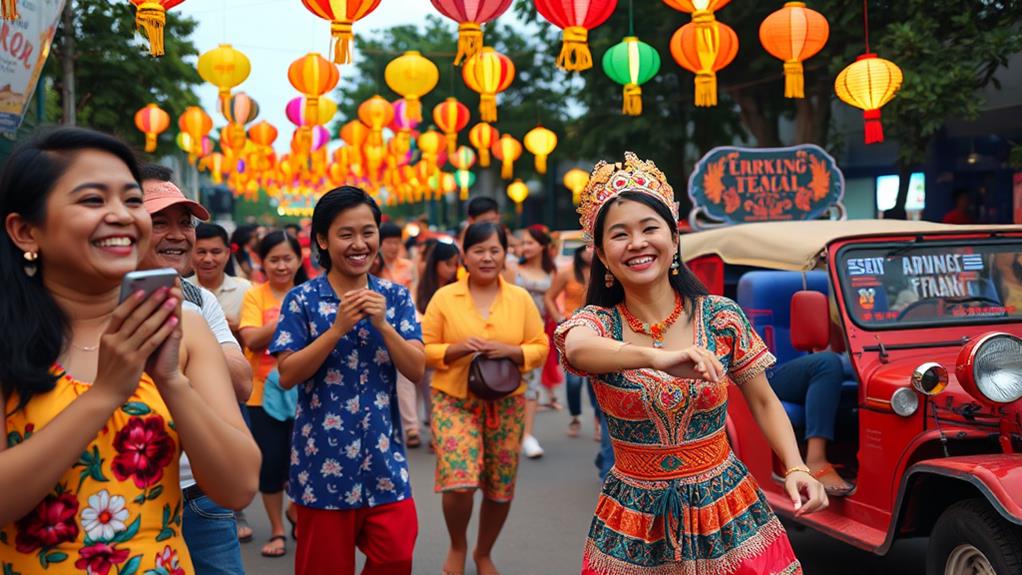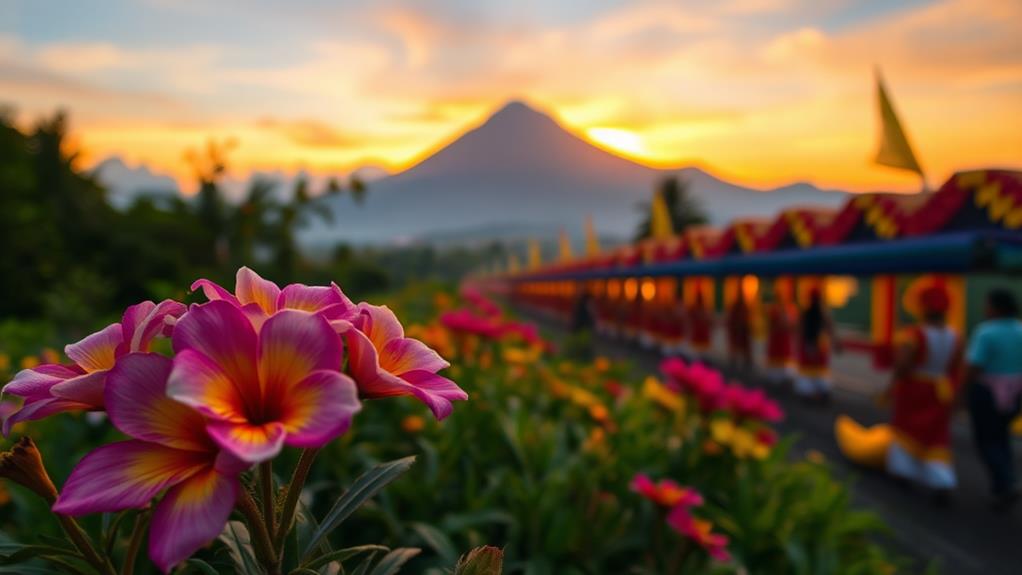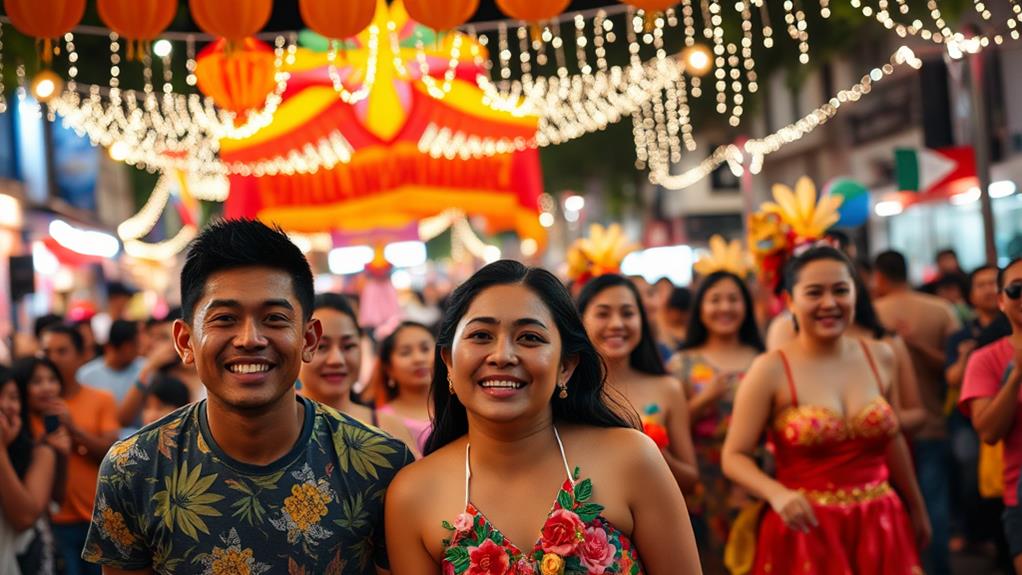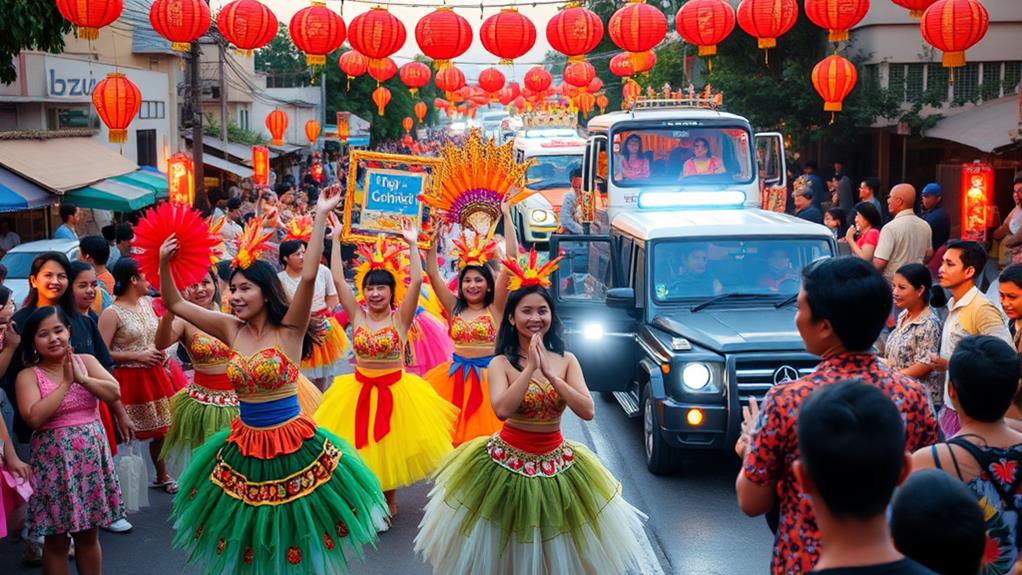To fully immerse in Philippine festivals, actively participate in the celebrations. This can be achieved by participating in traditional dances, such as the Tinikling or the Carinosa, which showcase the country's rich cultural heritage.
Engaging with locals through karaoke or basic Filipino phrases, like "Salamat" (thank you) or "Mabuhay" (cheers), can also help create meaningful connections.
Trying authentic Filipino cuisine is essential to the festival experience. Savoring popular dishes like Lechon (roasted pig) and Adobo (meat stew) can provide insight into the country's culinary traditions.
These flavors are often showcased in various festivals, such as the MassKara Festival, which celebrates the city of Bacolod's sugar industry.
Exploring the Philippines' natural beauty and cultural activities can further enrich the experience. Island hopping or hiking can provide opportunities to discover hidden gems, such as the stunning beaches of Boracay or the scenic mountains of Baguio.
Vibrant cultural activities, like street dancing competitions, can also offer a glimpse into local customs and traditions.
Experience the Vibrant Culture

The Philippines' vibrant culture is showcased through its many festivals, where dancing is an integral part of the celebrations.
These festivals bring together locals and tourists, offering a glimpse into the country's rich heritage. Two examples of major festivals are Sinulog and Kadayawan. Sinulog celebrates the country's devotion to Christianity, while Kadayawan highlights the importance of agricultural abundance. By understanding these themes, you can gain a deeper appreciation of the cultural context that informs these festivals.
Participating in local rituals and communal activities during Philippine festivals fosters unity and cooperation with the diverse communities that host these events.
For instance, during these festivals, locals and tourists participate in traditional dances and music, allowing everyone to appreciate the local customs that underlie these celebrations. This collective participation enables you to experience firsthand the warmth and hospitality that the Philippines is known for.
Savor Authentic Filipino Cuisine
The Philippines is home to a diverse range of authentic and mouth-watering dishes that showcase the country's culinary heritage. Lechon, a whole roasted pig, is often the highlight at many festivals. This traditional dish is a staple of Filipino celebrations, where it's typically served as the centerpiece of lavish banquets.
Regional specialties also play a significant role in Filipino cuisine. Bicol express, a spicy pork dish cooked in coconut milk, is a reflection of local flavors in the Bicol region. This dish is just one example of the many regional specialties that can be found throughout the Philippines.
Food stalls at festivals feature a variety of local delicacies, including adobo and sinigang, which are staple dishes in Filipino cuisine. These dishes give visitors an authentic taste of Filipino culture and community spirit.
Festive treats like bibingka and puto bumbong, rice cakes typically enjoyed during Christmas festivals, embody Filipino holiday traditions.
Participating in open house events during festivals allows visitors to experience the warmth of Filipino hospitality and the richness of their culinary offerings. Lavish banquets, often featuring a wide range of traditional dishes, are a hallmark of these events.
This culinary journey is an integral part of experiencing the vibrant culture of Philippine festivals, making it a memorable and authentic experience.
Connect With the Locals

Connecting with locals is key to unlocking unforgettable experiences during Philippine festivals. Engaging in conversations with locals allows you to gain valuable insights into the cultural significance of the celebrations. Filipinos are known for their friendliness and hospitality, making it easy to strike up a conversation.
To connect with locals, participate in karaoke sessions, a common local pastime. This helps to bond with Filipinos and share joyful experiences during festival gatherings. Learning a few basic Filipino phrases can also foster goodwill and respect. Common phrases to learn include "Salamat" (thank you) and "Mabuhay" (cheers or long life).
Building relationships with festival participants leads to memorable experiences and local insights into the best spots to enjoy food and festivities. For example, locals can recommend popular street foods, such as "lechon" (roasted pig) or "adobo" (a savory stew).
Festival friendships also deepen your connection with the community, allowing you to experience the true essence of Philippine festivals.
Connecting with locals provides a deeper understanding of the nation's rich cultural heritage. By engaging with the community, you'll gain insights into the history and significance of the festival.
This can lead to community storytelling, where you learn about personal festival traditions and stories.
Immerse in Traditional Dances
Immersing yourself in traditional dances at Philippine festivals offers a unique window into the country's rich cultural heritage. Engaging with these dances provides insight into the cultural significance behind each performance. For instance, festivals like Sinulog and Ati-Atihan showcase vibrant costumes and rhythmic movements that represent Filipino community spirit.
Participating in street dancing competitions is a great way to experience traditional dances firsthand. At festivals such as Kadayawan, local performers invite spectators to join in, encouraging audience participation. This allows you to experience the energy of the dance and learn the basic steps of tribal dances, which often feature rhythmic drum beats that promote cultural immersion.
Attending dance workshops or demonstrations enhances your experience and provides cultural insight. These workshops offer insight into the significance and history of traditional dances, allowing you to appreciate the cultural expressions on a deeper level.
For example, learning about the history of traditional dances helps you understand the cultural heritage of the Philippines and appreciate the vibrant festivals.
By immersing yourself in traditional dances, you'll develop a greater appreciation for the cultural heritage of the Philippines. This hands-on experience will enrich your understanding of the country's vibrant festivals and allow you to enjoy the performances on a deeper level.
Explore the Philippines' Natural Beauty

The Philippines' Natural Beauty Offers a Diverse Range of Attractions
The Philippines, with over 7,000 islands, offers a diverse range of natural attractions that draw visitors in with a sense of wonder and awe. These attractions include pristine beaches, lush mountains, and stunning waterfalls.
Exploring the Philippines' Natural Wonders
Visitors can explore the Philippines' natural wonders by participating in activities such as island hopping, hiking, and snorkeling and diving.
Popular hiking destinations include Mount Pulag and the Banaue Rice Terraces, while Tubbataha Reefs and Apo Reef are ideal spots for snorkeling and diving.
Promoting Sustainable Tourism
Eco-tourism initiatives promote sustainable visits to the Philippines' natural attractions, ensuring that the country's natural beauty is preserved for future generations.
Discover Hidden Gems and Tips
The Philippines has many lesser-known festivals and celebrations beyond its well-known events. These hidden gems offer unique and intimate experiences, often showcasing local traditions that larger festivals may overlook. For instance, the MassKara Festival in Bacolod City and the Pintados Festival in Tacloban City are smaller town festivals that provide authentic experiences of local culture.
Participating in community-led activities allows you to gain a deeper understanding of local culture. Joining traditional cooking classes, such as learning to make Adobo or Lechon, teaches you about local dishes and their cultural significance.
Engaging with local artisans and craftsmen, like weavers from the T'nalak tribe, offers insights into Filipino heritage and craftsmanship through interactive demonstrations.
Traditional craftsmanship showcases are a highlight of many festivals. These events allow you to appreciate the country's rich artisanal heritage, such as woodcarvings from the Ifugao people or textiles from the Cordillera region.
Community-driven events, like traditional dance workshops or open house gatherings, provide unique festival experiences and opportunities to immerse yourself in local culture.
Embracing the Fiesta Atmosphere

Immersing Yourself in Fiesta Traditions
Participating in traditional dances and music during festivals allows you to grasp the essence of fiesta traditions. These traditions are deeply rooted in a country's culture and heritage.
The vibrant costumes worn by dancers in festivals like Sinulog and Ati-Atihan reflect the rich cultural heritage and community spirit of the Philippines.
Celebratory Atmosphere of Festivals
Joining joyful parades and street parties helps you experience the excitement and energy of celebrations firsthand. Major festivals, such as the Panagbenga Festival, showcase the creativity and enthusiasm of the local community through elaborate events like flower floats.
Participating in these events connects you with the local culture and community on a deeper level.
Local Engagement and Cultural Immersion
Participating in karaoke sessions, a popular pastime during festivals, enables you to connect with the local culture and community.
This engagement allows you to understand the local customs and traditions more thoroughly.
What are some unique ways to fully immerse in the festivals of the Philippines, including Samal and Sinulog?
Experience the vibrant culture inside the philippines’ festivals by participating in unique activities such as joining the fluvial parade during the Samal Festival or taking part in the colorful street dancing of the Sinulog Festival. Immerse yourself in the local traditions, taste traditional food, and interact with friendly locals to truly embrace the festivities.
Learn Local Customs and Traditions
Understanding Local Customs and Traditions is Key to Appreciating Philippine Festivals
To fully appreciate the essence of Philippine festivals, it's essential to delve into the local customs and traditions that underpin them. Familiarizing yourself with the unique rituals, cultural symbolism, and festive attire of each celebration can enrich your experience and foster a deeper connection with the local community.
Learn about the Significance of Each Festival
Learning about the significance of each festival is crucial to understanding the cultural context. For example, the Sinulog Festival is a tribute to Santo Niño, showcasing the community's deep faith and devotion.
Participate in Traditional Activities
Participating in traditional tribal dances and activities helps experience the energy and spirit of the local culture. The Ati-Atihan Festival, for instance, features vibrant costumes and lively performances that reflect the community's heritage.
Engage with Locals to Learn about Unique Customs
Engaging with locals provides valuable insights into unique customs, such as face painting and attire worn during festivals. This helps gain a deeper understanding of the community's heritage and cultural practices.
Attend Events and Dress Respectfully
Attending food-centered events and dressing respectfully, such as wearing modest attire during religious festivals, demonstrates appreciation for the local culture and traditions. This thoughtful approach helps build connections with the community and fosters a more meaningful experience.
Create Unforgettable Memories

Create Unforgettable Memories in the Philippines
During your journey through the vibrant world of Philippine festivals, you'll have numerous opportunities to create unforgettable memories that will last a lifetime. To make the most of your experience, immerse yourself in traditional activities that foster a deeper connection with the culture and community spirit.
Immerse in Traditional Activities
Immersing yourself in traditional activities is key to creating unforgettable memories. Joining in tribal dances allows you to connect with the culture and community spirit. To participate, learn basic steps and showcase your moves. This will not only help you understand the dance but also earn you respect from the locals.
Engage with Locals
Engaging with locals is another way to create unforgettable memories. Join in their feasts during open house events, where food acts as a centerpiece, showcasing the warmth and hospitality integral to Filipino gatherings. Participating in local games also enhances cultural understanding and community bonding. Learn the rules and engage with locals to make the most of your experience.
Capture the Vibrant Atmosphere
To capture the vibrant atmosphere of the festivals, take festival photography tips into consideration. This will help you take memorable photos of the street parades and costume displays. Attending smaller, lesser-known festivals also provides a unique opportunity to experience local traditions and customs.
Enrich Your Understanding of Filipino Heritage
To enrich your understanding of Filipino heritage, attend unique local traditions and customs. Learn basic Filipino phrases and show respect to locals. This will encourage them to share cultural storytelling practices and local festival legends with you. By doing so, you'll gain valuable insights into cultural practices.
| Festival Experience | Tips for Participation | Expected Outcome |
|---|---|---|
| Tribal dances | Learn basic steps, join in, and showcase your moves | Deeper connection with culture and community spirit |
| Local games | Engage with locals, learn rules, and participate | Enhanced cultural understanding and community bonding |
| Street parades and costume displays | Capture vibrant atmosphere through festival photography tips | Lasting memories of the festival's vibrant atmosphere |
| Smaller, lesser-known festivals | Attend unique local traditions and customs | Enriched understanding of Filipino heritage |
| Cultural storytelling practices | Learn basic Filipino phrases, show respect, and encourage locals to share stories | Valuable insights into cultural practices and local festival legends
Questions and Answers
What Makes the Philippine Festival Unique?
The Philippine festival's uniqueness lies in its blend of vibrant traditions and rich cultural heritage.
This distinct blend is rooted in the country's history, customs, and hospitality. The festivals showcase the Philippines' diverse cultural influences, including Spanish, American, Chinese, and Malay traditions. Each festival is a reflection of the community's history and customs, such as the MassKara Festival's elaborate costumes and masks, which symbolize the city of Bacolod's resilience and creativity.
The festivals also foster community bonding, as people come together to celebrate and participate in various activities. For example, the Sinulog Festival's street dancing and processions, which honor the country's patron saint, Santo Niño, bring people from different walks of life together. The festivals' emphasis on community and cultural heritage sets them apart from other celebrations worldwide.
What Is the Essence of Festivals in the Philippines?
The essence of festivals in the Philippines can be understood through their cultural significance, community bonding, and historical roots.
Festivals in the Philippines are culturally significant because they showcase the country's rich heritage. For example, the Sinulog Festival in Cebu celebrates the country's Catholic faith and the conversion of the Filipino people to Christianity. Another example is the MassKara Festival in Bacolod, which highlights the city's sugar industry and the resilience of its people.
These festivals also promote community bonding by bringing people together to celebrate and have fun. The Ati-Atihan Festival in Kalibo, for instance, features a street dance competition that showcases the creativity and talents of the participants. Similarly, the Pintados Festival in Tacloban features a street dance and costume contest that promotes unity and friendship among the participants.
The historical roots of these festivals also contribute to their essence. Many of these festivals have been celebrated for centuries and have become an integral part of the country's culture and identity. For example, the Flores de Mayo festival has its roots in the Spanish colonial period, while the Kadayawan Festival in Davao celebrates the city's indigenous heritage.
What Is the Most Impressive Festival in the Philippines?
The Sinulog Festival in Cebu City is the most impressive festival in the Philippines. It is a showcase of vibrant parades that take place throughout the city, featuring elaborate costumes and choreographed dance routines. The festival holds rich cultural significance, as it commemorates the conversion of the native Cebuanos to Christianity and the arrival of Spanish conquistador Miguel López de Legazpi in 1565. A key aspect of the festival is the sampling of local cuisine, which offers a taste of traditional Filipino dishes such as lechon, sinugba, and kinilaw.
What Do Festival in the Philippines Offer People a Chance to Exhibit?
Festivals in the Philippines offer people a chance to exhibit cultural heritage and community unity.
Festivals showcase traditional dances, music, and costumes, serving as a means to express cultural identity. For instance, the Sinulog Festival in Cebu features elaborate costumes and choreographed dances that celebrate the island's history and faith.
Festivals also provide a platform to display local craftsmanship through various exhibits and activities. The MassKara Festival in Bacolod, for example, features a mask-making competition that highlights the city's artisanal skills.
Furthermore, festivals allow locals to demonstrate their culinary expertise by offering traditional delicacies and regional specialties. The Pista sa Nayon in Laguna showcases local cuisine, such as steamed rice cakes and coconut-based desserts, which are representative of the region's gastronomic heritage.